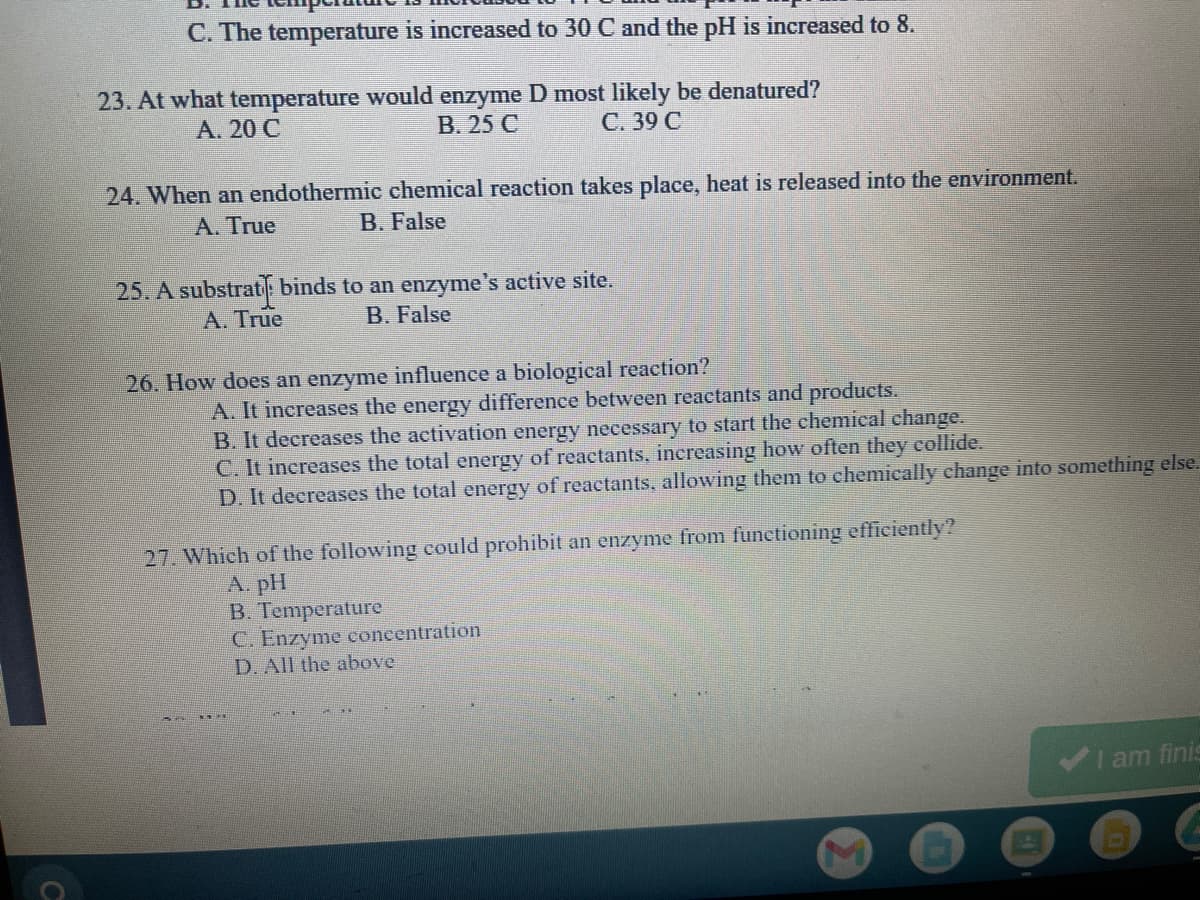23. At what temperature would enzyme D most likely be denatured? В. 25 С А. 20 С C. 39 C 24. When an endothermic chemical reaction takes place, heat is released into the environment. A. True B. False 25. A substrat binds to an enzyme's active site. B. False A. True 26. How does an enzyme influence a biological reaction? A. It increases the energy difference between reactants and products. B. It decreases the activation energy necessary to start the chemical change. C. It increases the total energy of reactants, increasing how often they collide. D. It decreases the total energy of reactants, allowing them to chemically change into someth 27. Which of the following could prohibit an enzyme from functioning efficiently? A. pH B. Temperature C. Enzyme coneentration D. All the above
23. At what temperature would enzyme D most likely be denatured? В. 25 С А. 20 С C. 39 C 24. When an endothermic chemical reaction takes place, heat is released into the environment. A. True B. False 25. A substrat binds to an enzyme's active site. B. False A. True 26. How does an enzyme influence a biological reaction? A. It increases the energy difference between reactants and products. B. It decreases the activation energy necessary to start the chemical change. C. It increases the total energy of reactants, increasing how often they collide. D. It decreases the total energy of reactants, allowing them to chemically change into someth 27. Which of the following could prohibit an enzyme from functioning efficiently? A. pH B. Temperature C. Enzyme coneentration D. All the above
Concepts of Biology
1st Edition
ISBN:9781938168116
Author:Samantha Fowler, Rebecca Roush, James Wise
Publisher:Samantha Fowler, Rebecca Roush, James Wise
Chapter4: How Cells Obtain Energy
Section: Chapter Questions
Problem 5RQ: Which of the following is not true about enzymes? a. They are consumed by the reactions they...
Related questions
Question
24

Transcribed Image Text:C. The temperature is increased to 30 C and the pH is increased to 8.
23. At what temperature would enzyme D most likely be denatured?
A. 20 C
B. 25 C
C. 39 C
24. When an endothermic chemical reaction takes place, heat is released into the environment.
A. True
B. False
25. A substrat binds to an enzyme's active site.
A. True
B. False
26. How does an enzyme influence a biological reaction?
A. It increases the energy difference between reactants and products.
B. It decreases the activation energy necessary to start the chemical change.
C. It increases the total energy of reactants, increasing how often they collide.
D. It decreases the total energy of reactants, allowing them to chemically ehange into something else.
27. Which of the following could prohibit an enzyme from functioning efficiently?
A. pH
B. Temperature
C. Enzyme concentration
D. All the above
I am finis
Expert Solution
This question has been solved!
Explore an expertly crafted, step-by-step solution for a thorough understanding of key concepts.
This is a popular solution!
Trending now
This is a popular solution!
Step by step
Solved in 2 steps

Knowledge Booster
Learn more about
Need a deep-dive on the concept behind this application? Look no further. Learn more about this topic, biology and related others by exploring similar questions and additional content below.Recommended textbooks for you

Concepts of Biology
Biology
ISBN:
9781938168116
Author:
Samantha Fowler, Rebecca Roush, James Wise
Publisher:
OpenStax College

Concepts of Biology
Biology
ISBN:
9781938168116
Author:
Samantha Fowler, Rebecca Roush, James Wise
Publisher:
OpenStax College